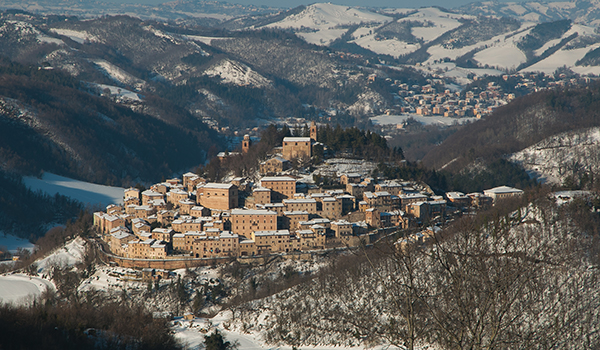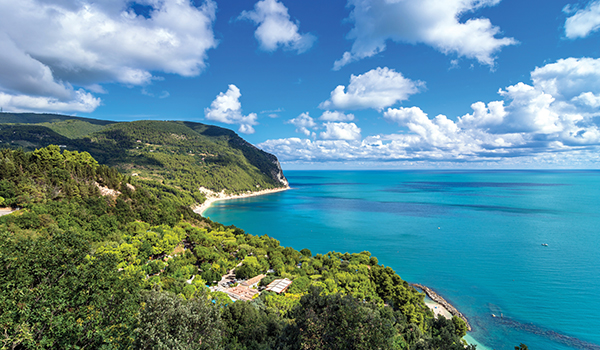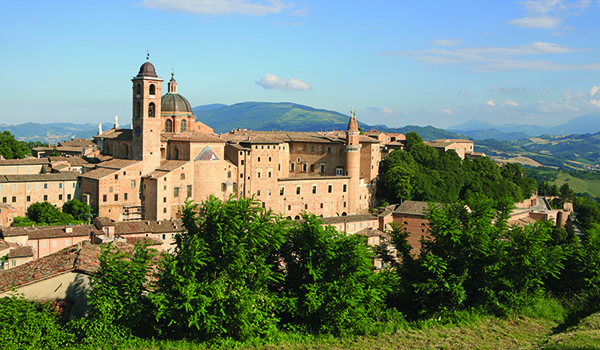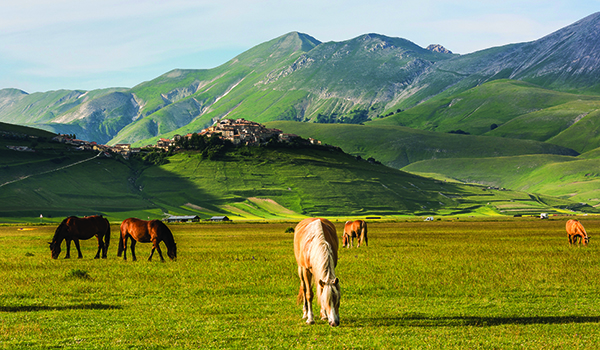Fleur Kinson explores the property potential of this diverse Italian region, so you can find the destination that suits you perfectly…

Introduction
Le Marche lies on the eastern side of Italy, east of Umbria, between majestic mountains and inviting sea. The region is split into five provinces: Pesaro-Urbino, Ancona, Macerata, Ascoli Piceno and the recently constituted Fermo. Its proximity to both mountains and sea makes it very appealing to prospective homebuyers.
The Adriatic coastline stretches some 180km and includes some of the best Italian Blue Flag beaches, while the steep eastern slopes of Italy’s mountainous backbone, the Apennines, includes the stunning Monti Sibillini in the south. The main autostrada, the A14, and the state highway SS16 run swiftly along the coast, but further inland they are slower as they weave up and down the region’s hills between towns. The regular intercity train connections at Ancona link the region with Bologna and Rome. Ancona is also the site of Le Marche’s international airport at Falconara, which is served by Ryanair from London Stansted.
Le Marche boasts 13 protected areas, forests and nature reserves, including the Monti Sibillini and the National Park at Monte Conero on the coast near Ancona. Historically, Le Marche has a remarkable historical heritage too, with its medieval hilltop towns and villages and more than 30 significant archaeological sites and 200 Romanesque churches, as well as the Renaissance city of Urbino.

The coast
The coast of Le Marche stretches from Pesaro to San Benedetto del Tronto, past stretches of sandy beach and clean blue water and numerous small seaside towns and villages. The region can boast one of the highest number of Blue Flag beaches of any region in Italy. Ancona sits almost half way down the coast and is the administrative capital, and a busy port. With its Greek heritage there are many interesting styles of architecture. A lot of the coastal resorts are relatively small and retain a certain old-fashioned charm.
The largest seaside resort is Pesaro, in the north, which is bursting with good shops and restaurants. Famous for being the birthplace of Gioachino Rossini, the town has an annual Opera Festival. Senigallia, a little further south, is known as the ‘Velvet Beach’ with its 13km of soft, golden sand. The Conero Riviera offers the jewel of Portonovo with its Napoleonic fort, idyllic Sirolo and its spectacular golf course, and the Liberty-style architecture of Porto San Giorgio. Continue down the coast for Pedaso, which hosts a famous mussel festival, Cupra Marittima and its imposing castle, and Grottammare with its medieval old town. Finally you come to San Benedetto del Tronto, the second largest resort after Pesaro. The fishing port is very busy in the summer with its pretty promenades and vibrant nightlife. The coast might be expensive for property, but it’s easy to get there from the inland towns.

Inland
Move inland from the coast and you will find the rolling hills and open fields of farming country, a peaceful landscape punctuated by pretty hilltop towns and gentle valleys. The quieter environment and slower pace of life make this is a popular area for British buyers. One of the region’s most eminent cities is Urbino. It rivals Florence for cultural significance and the more compact, bustling city has been designated a UNESCO World Heritage Site. Further south, the hill town of Macerata boasts one of Europe’s most outstanding outdoor theatres, the Arena Sferisterio, built in the 19th century to resemble an ancient Roman arena. The Stagione Lirica musical festival is held here every summer.
Close to the border with Abruzzo, the ancient town of Ascoli Piceno takes its name from the Picene tribe, who were conquered by the Romans in 89BC. The city was once a stop on the Via Salaria (the salt route) from Rome, but now enjoys a quieter existence. With one of the most beautiful marble-paved piazzas in Italy, and a wealth of medieval architecture, there’s plenty to enjoy.
Many other villages dot the landscape, including Arcevia (to the west of Ancona) perched on the foothills and surrounded by historic castles; Offida in the south with its unusual triangular piazza and memorable vin santo; and medieval Jesi, near Ancona, with its castle, cobbled streets and world-famous Verdicchio wines.

The mountains
The Monti Sibillini National Park was created in 1993 when 700sqm of mountainous wilderness was set aside as a site of outstanding natural beauty. Rising to more than 2,000m high, this is a popular destination for naturalists, skiers in winter and walkers in the summer. The mountains form the border with Umbria to the west and the highest peak is Mount Vettore, at 2,476m.
The area is dotted with medieval towns and criss-crossed with walking trails. There is shelter at the network of rifugi (mountain huts) across the range and all the maps and guides you need to plan your routes can be found at the Casa del Parco visitor centres. Popular nearby towns include Amandola with stunning views of the mountains, and Force, famed for its artisans and wrought iron work.
Fleur’s Homes in Le Marche feature has more essential advice for buying a home in this region.
